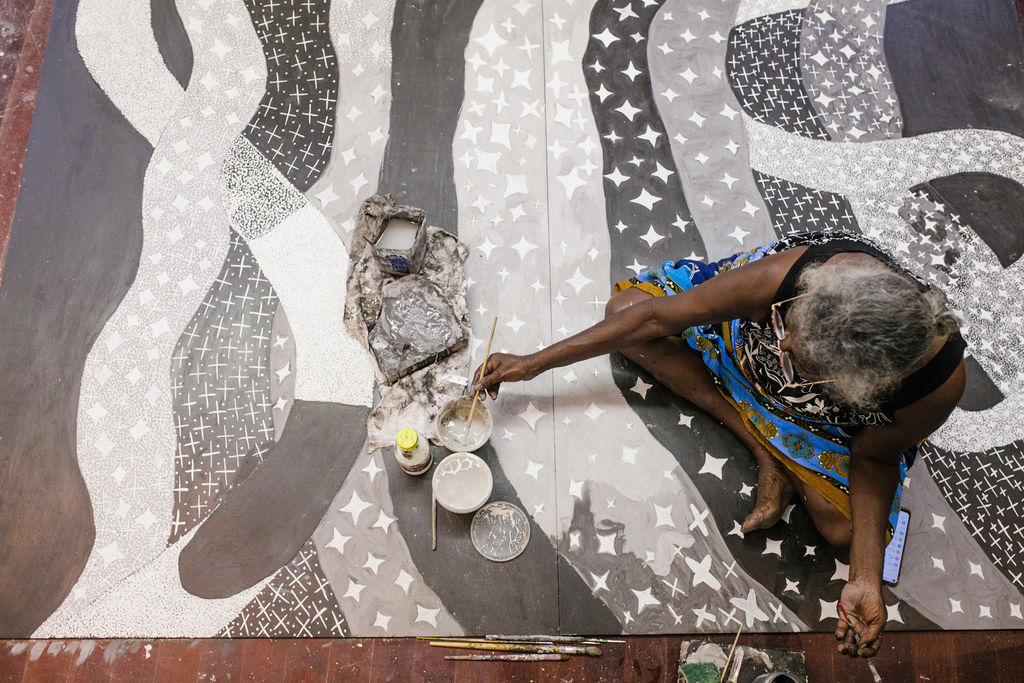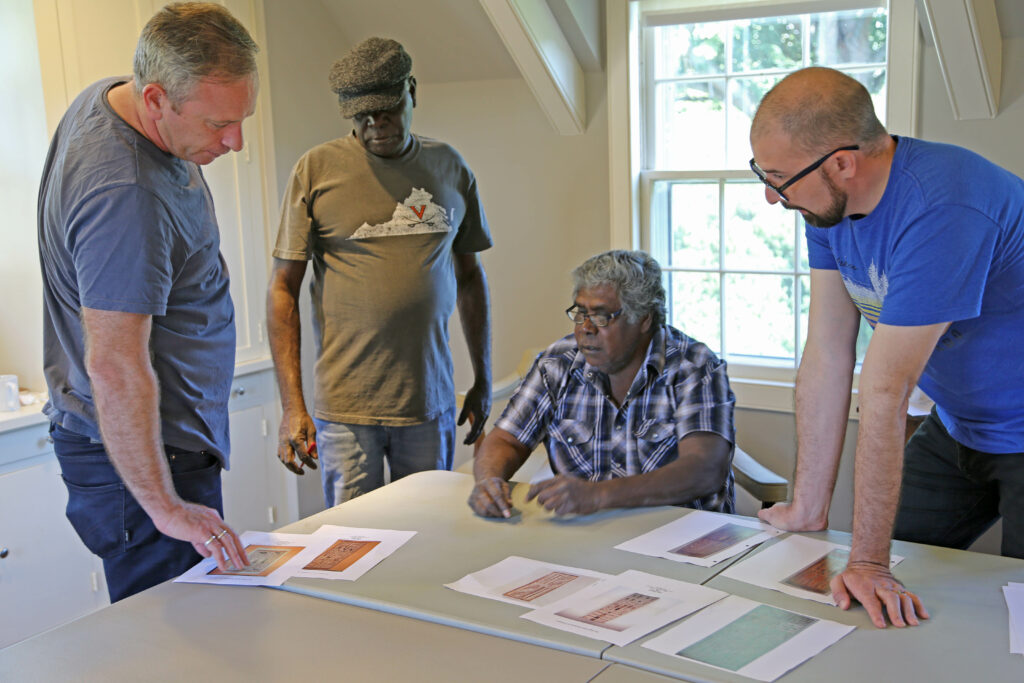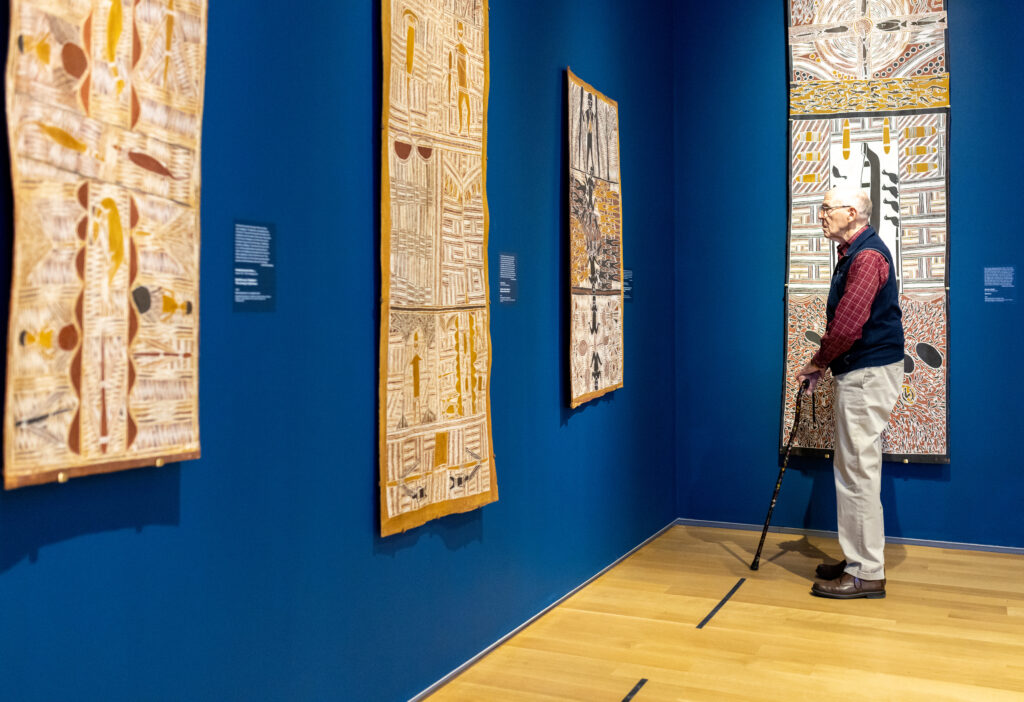Published in the November/December 2022 edition of Artscope Magazine

Merriam Webster provides a primary and secondary definition of Indigenous: “produced, growing, living or occurring natively or naturally in a particular region or environment” and “of or relating to the earliest known inhabitants of a place and especially of a place that was colonized by a now-dominant group.” Both definitions might be applied to the cultural foundations of two expansive exhibitions running concurrently at the Hood Museum in Hanover, New Hampshire. “Park Dae Sung: Ink Reimagined” and “Maḏayin: Eight Decades of Aboriginal Australian Bark Painting from Yirrkala” embody the preservation and development of personal and artistic identity in the wake of occupying influence, and the enduring strength of cultural tradition.
Born in Kyŏngsang Province in 1945, the year Japan surrendered its decades-long annexation of Korea, Park Dae Sung was five years old when he lost his parents to wartime violence, and he lost his left hand to the same violent conflict. Park dropped out of school as a young teen to escape the taunting and bullying of his peers. Calligraphy, drawing, and painting became mooring, centering constants for Park, and without access to formal training, he devoted himself to the lifelong pursuit of refinement and knowledge in developing his artistry. Park’s personal quest led him to visit the Diamond Mountains in the North, to walk the Silk Road in China, and eventually brought him to New York where he discovered the enchantment of cityscape.
Park’s work imparts a deep respect for traditional ink painting techniques, calligraphy and true-view painting while boldly incorporating innovative and often prescient approaches to scale, composition and stylistic variation. At The Hood, a single painting on paper spans an entire gallery wall, combining conceptual integrity and balance with almost supra-humanly precise brushwork (“Magnificent View of Samneung,” 2017, ink on paper). There is an inherent gentleness in the ink’s application, and an ethereal transcendence in Park’s landscapes portraying water, sky and vaulted rock (“Mt. Halla,” 2019, ink on paper).
Strongly influenced by Buddhist tradition as well as Christianity, the spiritual dynamics of Park’s practice are understated yet unmistakably present. “I am a Catholic but don’t draw specific figures or buildings for religious reasons,” Park shared in recent correspondence. “I control my mind balance by praying every day, every time. I believe the energy I get from those praises helps me develop as a good artist.
“As an artist, I think the core thing you should do is to practice basic skills constantly and keep the acuity to observe an object correctly,” Park continued. “For example, I never stop practicing calligraphy, which is essential for drawing. Even now, I put a lot of time and effort into writing and drawing right.”
When asked about the effect of personal losses he experienced as a young boy, during a presentation at the Korea Society in 2015, Park stated, “I feel that suffering is actually a prerequisite for developing a clear and peaceful mind. One of my mottos is to ‘lean into the discomfort.’” Continuing, Park said, “I feel that you need to have discomfort in order to have a clear and meditative state of mind to do your best work… I really try to live my life according to the laws of nature so that I can keep on working and keep that inspiration flowing.”
North-eastern Arnhem Land in the Northern Territory of Australia has been continuously inhabited by Indigenous peoples for at least 40,000 years. Among the Yolŋu people, sacred knowledge originating with Ancestors has been passed down generationally as song lines, ceremonies and visual patterns — each of which tell a story, or many stories, and carry indispensable guidance from which members of interrelated, yet distinct clans form their lives, laws and traditions.
Entrusted to the anointed few who guard their secrets, patterns are at once sacred expressions and a mapping of the way of life for all generations. The rituals of marking patterns date back thousands of years, and in the mid-20th century emerged in a new form as painting with locally-sourced pigments applied to strips of bark cut from the Eucalyptus tetrodonta tree. The technique of bark painting has been transmuted into the present day by a dedicated group of artists whose belief in the practice’s intrinsic worth and relevance drives a mission to bring the works to a wider audience of “balanda” (non-Yolŋu) in order to share the paintings’ figurative and literal intelligence, and the beauty they emanate.

“Maḏayin: Eight Decades of Aboriginal Australian Bark Painting from Yirrkala” is the result of a seven-year collaboration between the Kluge-Ruhe Aboriginal Art Collection of the University of Virginia, partnering with The Hood Museum; the Buku-Larrŋgay Mulka Centre in northern Australia, and primarily with the Yolŋu artists/curators themselves. As the only museum outside Australia dedicated to the exhibition and study of Indigenous Australian art, Kluge-Ruhe is uniquely positioned to support “Maḏayin,” and by naming the late multi-media artist Wukun Wanambi as curator, the exhibition became a visionary model in allowing an unfiltered voice to emerge directly from the Yolŋu. As Margo Smith, Director of the Kluge-Ruhe Aboriginal Art Collection, stated in her foreword to the 350-page hardbound exhibition catalogue “We do not pretend to understand Yolŋu art in the same ways Yolŋu knowledge holders do, recognizing and appreciating both their knowledge and the limits we encounter in fully comprehending Yolŋu culture.”
“Maḏayin” includes 90 individual pieces, 33 of which were specifically commissioned by Kluge-Ruhe for the exhibition. Entering the galleries housing “Maḏayin” at The Hood transports the viewer away from any lesser mundane concerns or worldly preoccupation, into a reality which seems to hover in a state of timeless suspension. Transfixing, almost hypnotic in their exquisite precision, intricate and complex patterns appear to reach outward from the undulant surfaces of cured eucalyptus bark, while simultaneously pulling the focus deeply inward, to a place of unspoken communion with all that makes us human. In a visual sense, the curatorial choice to raise each piece — some as tall as 12 feet — with empty space between wall and object, creates a compelling effect of weightlessness contrasting with the potent density of the works themselves.
Djutjatjutja Munuŋgurr’s “Dhuruputjpi,” 1996, natural pigments on eucalyptus bark, depicting the ancestral shark in ancient waters with a surrounding layer of patterned palm leaves, embodies the paradoxes of precision and fluidity, delineation and inclusion. Bright yet somber, there is an elemental reverence in the deliberate application of detail and design. The sinuous order of Barrupu Yunupiŋu’s “Gurtha (Ancestral Fire),” 2010, natural pigments on eucalyptus bark, pushes against boundaries of interrelation and fragmentation, forming an implied unity which supersedes the separation of its individual parts.

“Maḏayin: Eight Decades of Aboriginal Australian Bark Painting from Yirrkala” represents what is best in intercultural collaboration. By approaching the exhibition in a spirit of appropriate humility and with an openness to learning, museum leadership have allowed each work to directly express its origins and meaning without an imposed interpretive perspective of the societal outsider. As Jami Powell, Curator of Indigenous Art at the Hood Museum, shared in recent correspondence, “For too long Indigenous art has been contextualized and presented within colonial frameworks. Having the Yolŋu artists as the lead curators on Maḏayin was essential to the exhibition’s success. Their leadership and guidance helped focus our attention on what aspects of the work and narrative were most important to the Yolŋu themselves and how they wanted their work to be shared with the public. This centering of Indigenous, and particularly Yolŋu, ways of knowing and being in the world is characterized by an incredible intellectual and aesthetic generosity that benefits all audiences.”
Kinship and cooperative living have stood as the basis for Yolŋu society for millennia, and the importance of communal interest in guiding behavior, in addition to the paintings’ stunning visual impact, are clearly relevant to the intended viewing audience of “Maḏayin.” As Djambawa Marawili AM, Chairman of Buku-Larrŋgay Mulka Centre wrote in his foreword, “We are the Yolŋu people of northeast Arnhem Land. In this exhibition, we are telling this to you in the United States. We are sending our paintings across the sea to share with you that we have our own identity, our own sacred objects, our own songlines, our own patterns and designs, our own maḏayin (sacred system). This is not just an exhibition but is us sharing with you the ancestral knowledge that runs in our soul and our blood. We have been keeping this identity for thousands and thousands of years, and now we are sharing it with you.”